 KTM 390 Adventure - Owner's Manual > Troubleshooting, Technical data
KTM 390 Adventure - Owner's Manual > Troubleshooting, Technical data
Troubleshooting
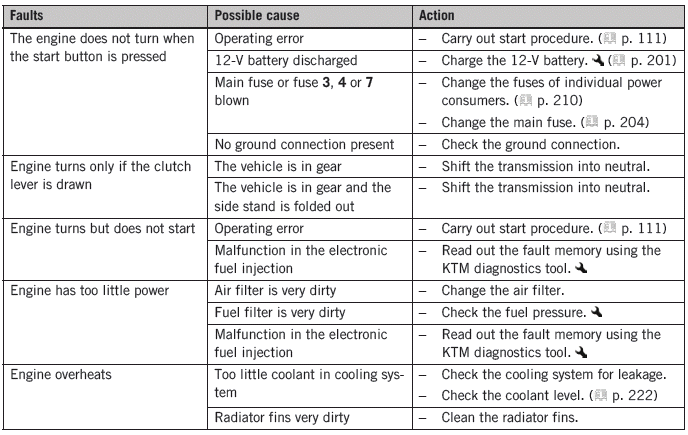


Technical data
Engine
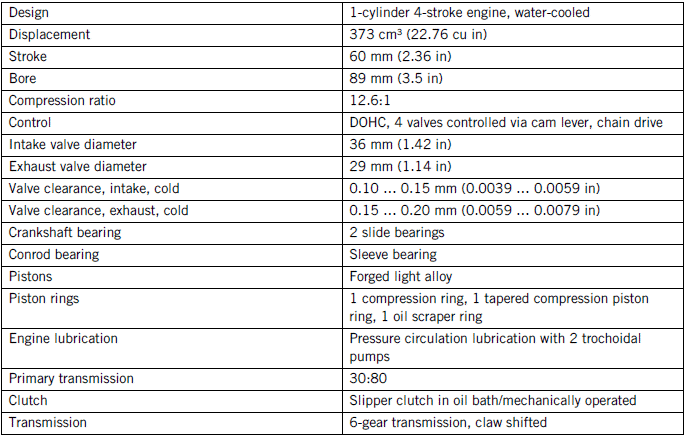

Engine tightening torques

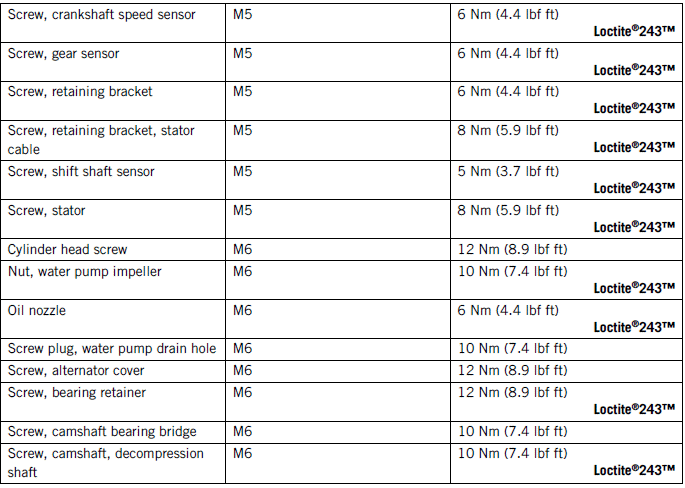
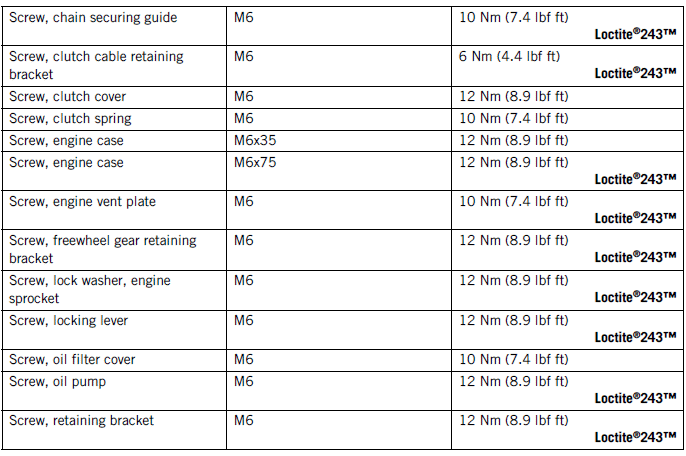
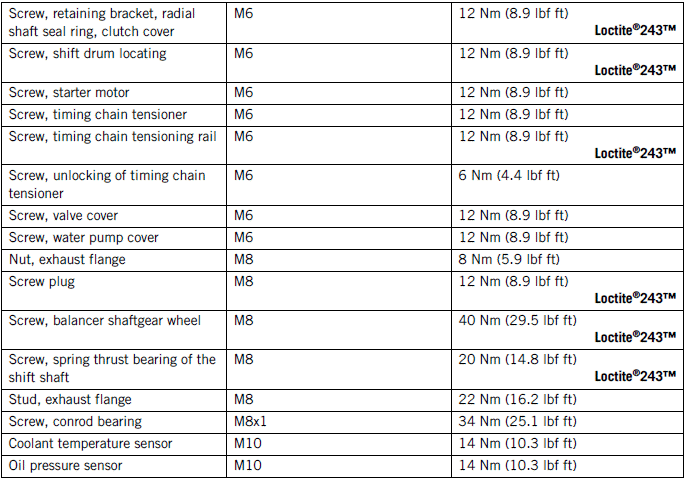
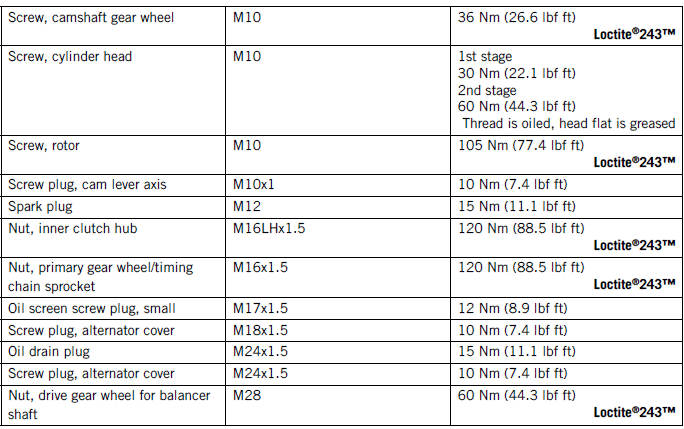
Capacities
Engine oil

Coolant

Fuel

Please observe the labels on EU fuel pumps.


Chassis

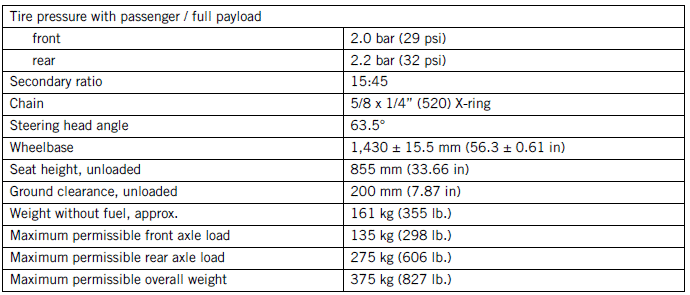
Electrical system


Tires

Fork


Shock absorber


Chassis tightening torques
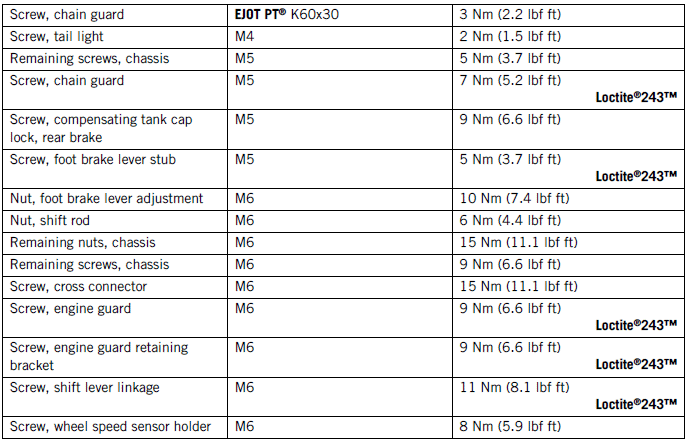
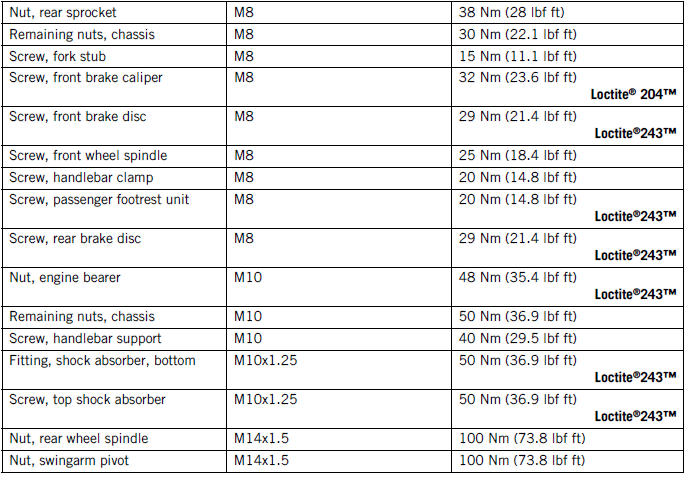

SUBSTANCES
Brake fluid DOT 4 / DOT 5.1
Standard/classification
- DOT
Guideline
- Use only brake fluid that complies with the specified standard (see specifications on the container) and that exhibits the corresponding properties.
Recommended supplier
Castrol
- REACT PERFORMANCE DOT 4
MOTOREX
- Brake Fluid DOT 5.1
Coolant
Guideline
- Only use high-grade, silicate-free coolant with corrosion inhibitor additive for aluminum motors. Low grade and unsuitable antifreeze causes corrosion, deposits and frothing.
- Do not use pure water as only coolant is able to meet the requirements needed in terms of corrosion protection and lubrication properties.
- Only use coolant that complies with the requirements stated (see specifications on the container) and that has the relevant properties.
Antifreeze protection to at least -25 ºC (-13 ºF)
The mixture ratio must be adjusted to the necessary antifreeze protection. Use distilled water if the coolant needs to be diluted. The use of premixed coolant is recommended. Observe the coolant manufacturer specifications for antifreeze protection, dilution and miscibility (compatibility) with other coolants.
Recommended supplier
MOTOREX
- COOLANT M3.0
Engine oil (SAE 15W/50)
Standard/classification
- JASO T903 MA2
- SAE (SAE 15W/50)
Guideline
- Use only engine oils that comply with the specified standards (see specifications on the container) and that possess the corresponding properties.
Semi-synthetic engine oil
Recommended supplier
MOTOREX
- Formula 4T
Fork oil (SAE 4) (48601166S1)
Standard/classification
- SAE (SAE 4)
Guideline
- Use only oils that comply with the specified standards (see specifications on the container) and that exhibit the corresponding properties.
Shock absorber fluid (SAE 2.5) (50180751S1)
Standard/classification
- SAE (SAE 2.5)
Guideline
- Use only oils that comply with the specified standards (see specifications on the container) and that exhibit the corresponding properties.
Super unleaded (ROZ 95/RON 95/PON 91)
Standard/classification
- DIN EN 228 (ROZ 95/RON 95/PON 91)
Guideline
- Only use unleaded super fuel that matches or is equivalent to the specified fuel grade.
- Fuel with an ethanol content of up to 10 % (E10 fuel) is safe to use.
Info Do not use fuel containing methanol (e. g. M15, M85, M100) or more than 10 % ethanol (e. g. E15, E25, E85, E100).
STANDARDS
JASO T903 MA2
Different technical development directions required a separate specification for motorcycles - the JASO T903 MA2 standard. Earlier, engine oils from the automobile industry were used for motorcycles because there was no separate motorcycle specification. Whereas long service intervals are demanded for automobile engines, the focus for motorcycle engines is on high performance at high engine speeds. In most motorcycle engines, the transmission and clutch are lubricated with the same oil. The JASO T903 MA2 standard meets these special requirements.
SAE
The SAE viscosity classes were defined by the Society of Automotive Engineers and are used for classifying oils according to their viscosity. The viscosity describes only one property of oil and says nothing about quality.
INDEX OF SPECIAL TERMS


LIST OF SYMBOLS
Red symbols
Red symbols indicate an error condition that requires immediate intervention.
 The oil pressure warning lamp
lights up red - The oil pressure is too low. Stop immediately, taking care not
to endanger yourself or other road users in the process, and switch off the
engine.
The oil pressure warning lamp
lights up red - The oil pressure is too low. Stop immediately, taking care not
to endanger yourself or other road users in the process, and switch off the
engine.
Yellow and orange symbols
Yellow and orange symbols indicate an error condition that requires prompt intervention. Active driving aids are also represented by yellow or orange symbols.
 Malfunction indicator lamp
lights up yellow - The OBD has detected a malfunction in the vehicle electronics.
Come safely to a halt, and contact an authorized KTM workshop.
Malfunction indicator lamp
lights up yellow - The OBD has detected a malfunction in the vehicle electronics.
Come safely to a halt, and contact an authorized KTM workshop.
 The ABS warning lamp lights up
yellow - Status or error messages relating to ABS. The ABS warning lamp flashes
if the ABS mode Super Moto is enabled.
The ABS warning lamp lights up
yellow - Status or error messages relating to ABS. The ABS warning lamp flashes
if the ABS mode Super Moto is enabled.
 TC indicator lamp lights up
yellow - MTC is not enabled or is currently intervening. The TC indicator lamp
also lights up if a malfunction is detected. Contact an authorized KTM workshop.
TC indicator lamp lights up
yellow - MTC is not enabled or is currently intervening. The TC indicator lamp
also lights up if a malfunction is detected. Contact an authorized KTM workshop.
The TC indicator lamp flashes if MTC makes an active intervention.
 The general warning lamp lights
up yellow - A note/warning note on operating safety has been detected. This is
shown in addition.
The general warning lamp lights
up yellow - A note/warning note on operating safety has been detected. This is
shown in addition.
Green and blue symbols
Green and blue symbols reflect information.
 The turn signal indicator lamp
flashes green simultaneously with the turn signal - The turn signal is switched
on.
The turn signal indicator lamp
flashes green simultaneously with the turn signal - The turn signal is switched
on.
 The idle indicator lamp lights
up green - The transmission is in neutral.
The idle indicator lamp lights
up green - The transmission is in neutral.
 The high beam indicator lamp
lights up blue - The high beam is switched on.
The high beam indicator lamp
lights up blue - The high beam is switched on.
See also:
 KTM 390 Adventure - Owner's Manual > Checks and maintenance steps for winter operation
KTM 390 Adventure - Owner's Manual > Checks and maintenance steps for winter operation
Info If you use the motorcycle in winter, you must expect salt on the roads. You should therefore take precautions against aggressive road salt. Clean the motorcycle with cold water if it has been used on salted roads. Warm water enhances the corrosive effects of salt. Clean the motorcycle. Clean the brakes.

 Benelli Imperiale 400
Benelli Imperiale 400 BMW F900XR
BMW F900XR Honda CB500X
Honda CB500X KTM 390 Adventure
KTM 390 Adventure Triumph Street Triple S
Triumph Street Triple S Yamaha MT-03
Yamaha MT-03 Kawasaki Z400
Kawasaki Z400 Triumph Street Triple S
Triumph Street Triple S Yamaha MT-03
Yamaha MT-03